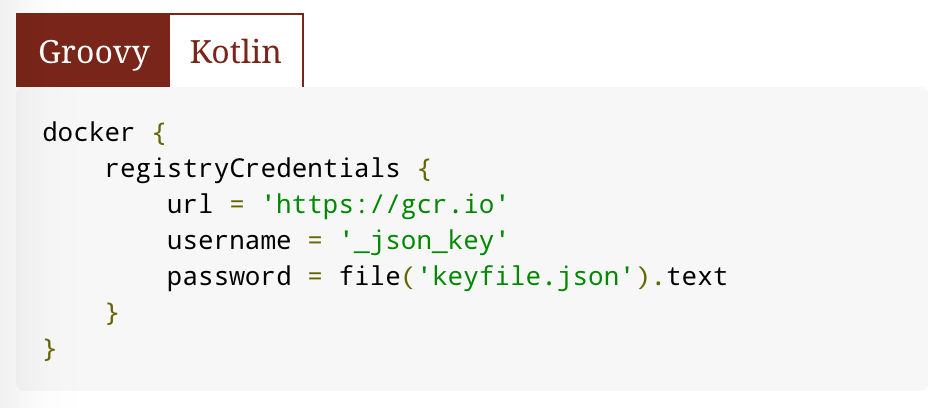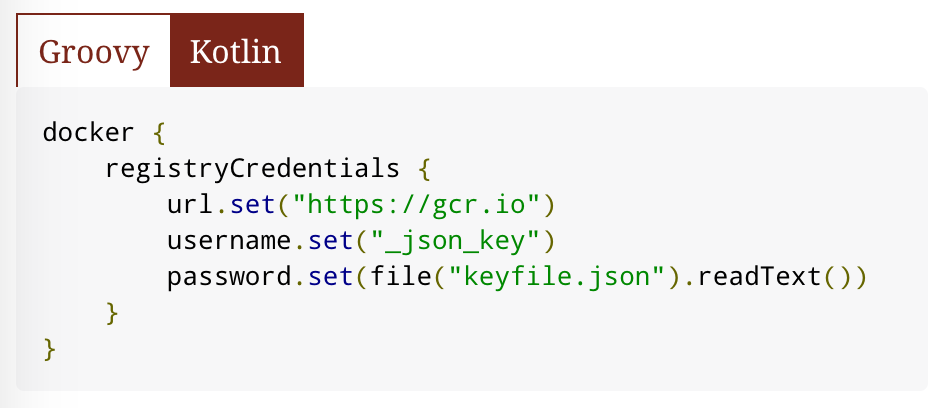AsciidoctorJ tabbed code extension 
Using the extension
All you need to do to use the extension is to add it to the dependency from Maven Central. The following two examples demonstrate the use of version 0.3 from Maven and Gradle.
<dependency>
<groupId>com.bmuschko</groupId>
<artifactId>asciidoctorj-tabbed-code-extension</artifactId>
<version>0.3</version>
<scope>runtime</scope>
</dependency>dependencies {
runtimeOnly("com.bmuschko:asciidoctorj-tabbed-code-extension:0.3")
}|
Important
|
This extension is based on AsciidoctorJ version 2.0.0. Make sure that the consuming project uses that exact version (or greater) to avoid incompatibilities.
If you need a version compatible with an older version of AsciidoctorJ (down to 1.6.0-RC1) then use version 0.2 of this extension.
|
To use the extension in Asciidoc provide code blocks with different roles. Specify the primary role for the code block that should appear in the first, topmost tab to the left and use the secondary role for all other tabs. The extension uses the title of the code block for rendering the tab label.
[source,groovy,indent=0,subs="verbatim,attributes",role="primary"]
.Groovy
----
docker {
registryCredentials {
url = 'https://gcr.io'
username = '_json_key'
password = file('keyfile.json').text
}
}
----
[source,kotlin,indent=0,subs="verbatim,attributes",role="secondary"]
.Kotlin
----
docker {
registryCredentials {
url.set("https://gcr.io")
username.set("_json_key")
password.set(file("keyfile.json").readText())
}
}
----Configuring the extension
Under the hood, the extension uses the JavaScript library Zepto.js. Currently, the JavaScript library is not configurable.
By default, the extension provides a JavaScript and CSS file that already takes care of the runtime behavior and styling. The runtime behavior and styling is configurable. The table below shows the attributes that allow you to configure the extension.
Attribute |
Default Value |
Description |
|
The JavaScript controlling the behavior read from the runtime classpath. |
|
|
The CSS controlling the styling read from the runtime classpath. |
The following example shows how to use the CSS attributes to provide custom styling in a Gradle build using the Kotlin DSL.
tasks.named<AsciidoctorTask>("asciidoctor") {
sourceDir = file("src/docs/asciidoc")
sources(delegateClosureOf<PatternSet> {
include("index.adoc")
})
attributes(
mapOf(
"toc" to "left",
"source-highlighter" to "prettify",
"icons" to "font",
"numbered" to "",
"idprefix" to "",
"docinfo1" to "true",
"sectanchors" to "true",
"tabbed-code-css-path" to "/customTabbedCode.css"
)
)
}
